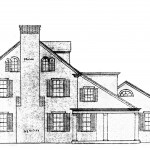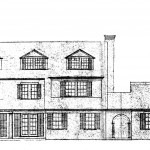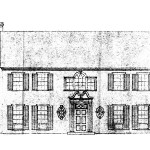
The houses of Hamden’s Swarthmore Street possess delicate bones. Place them atop poles and each home would look like the finest handmade birdhouse. These colonials and their siblings, over one hundred and ten houses in total, have presided over streets in Hamden, New Haven, and Cheshire since the 1920s, when they were designed and built by Alice Washburn.
Washburn began her career as a landscape architect in 1919 at age 49. She had no formal training. By 1933 she was bankrupt, retired, and living in quiet obscurity with her sister in Cheshire. When she died 25 years later, Washburn’s death certificate listed her occupation as “housewife.” But her clients remembered and passed on her name to the next owners of their homes. In 1984 Martha Buck, known then as Martha Yellig, began asking about the Swarthmore Street houses where she dropped off her young son for playdates. Buck learned only the builder’s name and sex: Washburn, female.
Buck, at forty-something years old and in the midst of a divorce, had returned to school to pursue a college degree in art history. She selected the work of the prolific Washburn as the subject of her senior paper at Southern Connecticut State University. But the woman who had speculated and designed better than most men was also discreet—Washburn disposed of all her personal records. “I just kept hitting dead end after dead end,” Buck recalled in an interview in late March. Not even Washburn’s granddaughter knew much about the woman, she added. Eventually she found building permits that listed not only Washburn but also the names of her workmen. “I cannot tell you how exciting it was for me to find her signature,” Buck said. Facts emerged: Washburn was a mother of two and the wife of a wallpaper manufacturer. Family history said that she had been a schoolteacher. Buck used these leads to produce an essay constructed largely around anecdotal evidence gathered from homeowners and the offspring of Washburn’s employees. Buck received her degree in 1985.

By 1990, Washburn’s story had fallen into the hands of Mimsie Coleman, then the co-president of the Arts Council of Greater New Haven. Coleman, a journalist and Washburn homeowner herself, decided that the architect was worthy of commemoration. The council coordinated with the Hamden Historical Society and the Eli Whitney Museum to mount an exhibit and organize a house tour. The New York Times covered the event. The house tour alone brought in $10,000, according to Eli Whitney Museum Director William Brown. Martha Buck even agreed to produce an informational pamphlet for the event.
But Buck’s loosely written narrative did not satisfy Brown. To him, Buck lacked the discipline of a trained architectural historian. She was “a woman who found a really wonderful story and didn’t know what to do about it,” he said. Negotiations grew heated, money and exhibition priorities became points of contention, and Buck arranged to print her work independently. She and two friends fronted and then sold the press run of about 1,000 copies.

Admittedly, the Washburn story is not that of a revolutionary designer. However, unique and idiosyncratic grace saturates the work she left behind. Coleman, ordinarily articulate, allowed her voice to trail off indistinctly when she tried to describe the charm of her own Washburn. Brown, Buck, and Coleman called Washburn’s style “intimate,” “filled with light,” and “warm.”
“It’s how wide they typically are, but it’s also the height of the window. It’s obviously the leaded glass fan light above the front door, the moldings, the crown moldings, and the ornateness of the fireplace,” John Cuozzo said of the colonials. Cuozzo is a Hamden realtor who has been selling Washburns for decades—since before the name became an adjective. He added that their proportions explain the way they sell for more than other houses in the same neighborhoods with the same amount of floorspace. It was evident to me, even in the dim gaze of a March sun, that the precision of the Swarthmore Street houses outshines the clumsier lines of their neighbors.
Coleman’s house shows that Washburn squeezed a lot into a tiny space. The living room frames a large, finely carved fireplace on fluted columns and the library wraps around miniature French doors. The fireplace, columns, and doors are all Washburn signatures. The fine millwork—by all accounts designed and overseen by Washburn personally—endows each Washburn house with its splendor.
The construction of this house and of the other Washburns occurred at a transformative period in the countryside around Hamden. Washburn worked during a time when more and more professionals were moving outside of the city proper and commuting via trolley or car to the office—the time when suburbia was born. And, at least during the decade she worked, it looked as if Washburn’s precise construction might become the standard for future development around New Haven.
But generous and gutsy business practices ultimately ran Washburn into debt. Buck said that Washburn not only took all the financial risk on herself by designing on speculation, but she also would not charge when it became apparent that a family could not provide the wages for extra work.
Washburn’s appeal comes from the combination of the charisma of her creations and the enigma of her motivations. She provides the perfect foundation on which to construct any personality. Buck’s 1990 publication depicts Washburn as a lady who used her female sensibility to understand how to appropriately define the domestic realm. But when we spoke in late March over coffee, Buck imagined Washburn as a different kind of creative force. “She was a builder first and a lady second,” Buck told me. Just as Washburn designed without access to formal architectural training, Buck constructed her historical narrative from speculation. Buck’s Washburn was generous to a fault, building more for her clients than they paid for, and possessed exacting standards, demanding perfection from her craftsmen. From what Buck drew from children of clients or employees, she erected an image of a passionate, intelligent, distant woman. However, Buck couldn’t answer the biggest question about Washburn’s life.
“What made her think that she could do this?” she asked, shrugging. We can’t know the answer. But even if the paint peels on the Washburn homes, if their floorboards sag, or if their interiors are gutted for renovation, we can hope the architect herself will be remembered for having had the audacity to build them.


